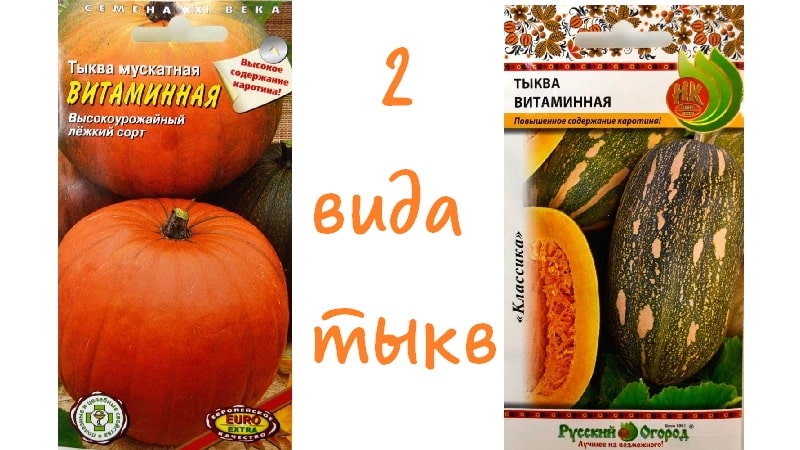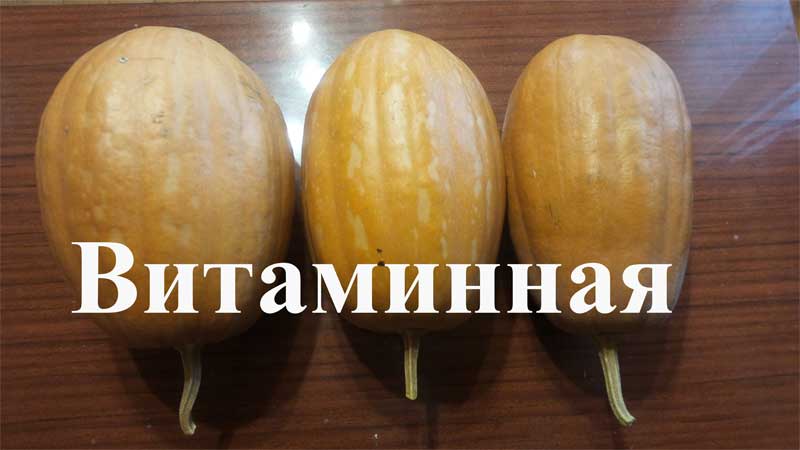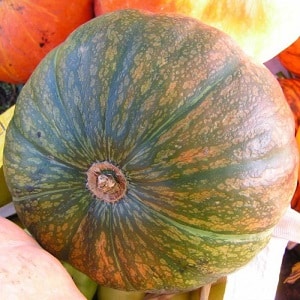One of the most popular varieties of pumpkin “Vitaminnaya”: how to get a rich harvest of a healthy and tasty vegetable
Today we will talk about one of the most popular varieties of pumpkin - Vitamin. From the name it is clear that this is not just a pumpkin, but a storehouse of vitamins and microelements. In the article we will talk about the features of this culture and its disadvantages. You will learn how to properly plant and grow this orange vegetable to get a rich harvest.
Description of the variety and distinctive features of Vitaminnaya pumpkin
Variety Vitaminnaya – late ripening. Full ripening from the moment the seeds are planted takes at least 130 days. Therefore, growing this variety in regions with cold climates is not recommended.
In such conditions, the pumpkin will not have time to ripen before the onset of autumn frosts. And even in warm climates, experienced vegetable growers recommend growing Vitamin in seedlings.
The photo shows a pumpkin of the Vitaminnaya variety.

Fruit characteristics
The fruits of the Vitaminnaya variety are oval-shaped, dark green, orange-green or dark orange in color. The peel is thin. The weight of one pumpkin is about 5-7 kg. The flesh is bright orange, aromatic, sweet, crispy, and at the same time tender.
Productivity
Pumpkin has a high yield (3.7-4.4 kg/m2). It is stored for a long time and tolerates transportation well.
How to grow
Vitamin Pumpkin is a heat-loving plant. It can be planted in the ground with seeds only in the southern regions, where there are no frosts in mid-autumn. At the time of planting, the ground should warm up to 13°C.
In the middle zone and in the northern regions, the seedling method is used.
Seed preparation
First of all, pumpkin seeds are heated. Do this for 1-2 months near a heating device or stove. Warming up increases the chances of getting more female flowers - and therefore a good harvest. Then the planting material is prepared.
Preparation consists of a number of activities:
- Seed selection. Empty seeds are discarded at this stage. To determine whether the seeds are empty or not, they are placed in a salt solution. Those that do not drown are empty and not suitable for planting. They will not sprout.
- Hardening. The seed, wrapped in a damp cloth, is kept for three days in the refrigerator on the bottom shelf. This helps the seedlings adapt more quickly to weather changes.
- Disinfection. Before planting, the seeds are soaked for 10 hours in a weak solution. potassium permanganate or water with aloe juice.
Seedling
Seeds are planted for seedlings in early May. Most gardeners use special pots with nutrient soil. Seedlings require regular moisture, but excessive moisture should be avoided.
Pots with seedlings are covered with film, creating a greenhouse effect, but ventilation must be provided periodically.
Landing
Vitamin does not like the cold, so the bed should be warm. To do this, it is covered with film. Also, small holes are prepared in the beds and spilled with hot water. If there has been no rain in the coming days, then pour at least two liters into each hole. After planting, the roots of the plants are covered with peat.
At the beginning of June, the seedlings are transferred to the beds. By this time, three leaves usually appear on it. It is buried up to the cotyledons. Vitamin pumpkin seeds are planted during the same period.The distance between adjacent holes is made about 0.7-1 m. If frosts are still expected, then the beds must be covered with film.
Important! This is a heat-loving pumpkin variety. Experienced farmers recommend planting seeds or seedlings under a greenhouse even in June.
Care
Caring for Vitaminna consists of pinching the side vines and the main stem, watering, loosening, weeding and fertilizing. Much attention is paid to caring for the lashes. As the pumpkin grows, it produces many twining stems. They are anchored in the soil with antennae. Such shoots allow the plant to receive nutrients along its entire length.
As soon as the lash grows, in the places where the tendrils appear, they are sprinkled with earth and additionally watered. The stems should not be cut or moved.
Important! The soil under the bushes is additionally mulched with straw or humus. This is done to retain moisture and prevent weeds from growing.
As soon as the first shoots appear, the pumpkin is thinned out. But this only applies to direct planting of seeds in a hole. If 3–4 bushes have sprouted, 1–2 of them are left. Seedlings are thinned out only after several leaves have formed. They are carefully cut at ground level so as not to damage the roots of the plant.

Watering
The plant does not require watering, but during dry periods it is irrigated twice a week. This is done strictly at the root so that water does not get on the vines. Two weeks before harvest, watering is completely stopped. If this is not done, the pumpkin peel will be thin and the fruit itself will be watery. Such a vegetable will quickly deteriorate and will not last even until winter.
Loosening
Loosening the soil plays an important role when growing pumpkin crops. This is the only way to provide the plant’s roots with a sufficient amount of oxygen.
Groundbaits
For the growth and proper development of fruits, the plant is regularly fed. Both organic fertilizers (chicken droppings or cow manure diluted in water) and mineral fertilizers are used as fertilizing.
There is a certain scheme for fertilizing Vitaminnaya pumpkin. For all muscat varieties it is the same:
- when germinating seeds - three weeks after sowing;
- the first feeding is carried out a week after planting the seedlings in open ground;
- Every 3-4 months, fertilizers are regularly applied until the ovaries appear.
For the first feeding, cow manure or chicken droppings are diluted in water in a ratio of 1:4 (1 part manure/droppings and four parts water). Until the ovaries appear, the pumpkin is fertilized with a garden mixture or wood ash.
The proportions are the same - take 50 g of dry matter per 10 liters of water. In cold summers, the pumpkin is sprayed with an additional urea solution: take 10 g of urea per 10 liters of water.
Important! Pumpkin does not like acidic soil. Therefore, after applying organic fertilizers that increase acidity, wood ash is added. It is introduced during watering (take 2 cups of ash per bucket of water) or sprinkled on top.
Features of cultivation and possible difficulties
Pumpkin doesn't like the cold. It is best to prepare high beds for it, cover them in advance with a transparent film or mulch them with manure. Fertilize the area in the fall. If there are not enough vitamins in the soil, the pumpkin will lose leaves and flowers.
Growing tips from experienced gardeners
Growing and caring for pumpkins has its own peculiarities. Experienced gardeners advise adhering to the following rules:
 Pinch the main stem of the pumpkin when it reaches 1.5 m in length.
Pinch the main stem of the pumpkin when it reaches 1.5 m in length.- Leave only two lashes on each plant.
- Pick off all the fruits, leaving only 1-2 pumpkins on one vine.
- Pin the canes to the ground and add soil to improve the root system.
- Place boards, bricks under the fruits, or hang pumpkins in a net from a support.
- During the growth period, water the plant abundantly and regularly.
- Fertilize pumpkins with cow manure and nitrophosphoric acid twice a month.
- Reduce watering in late summer.
Diseases and pests
An important point in caring for any plant is protecting it from diseases and pests. Vitamin pumpkin is the most resistant to diseases and pests compared to other varieties. However, it is also susceptible to diseases such as bacteriosis, powdery mildew and white rot.
In case of bacteriosis, the affected plant is completely removed and the place where it grew is disinfected. Then the adjacent stems are treated with Bordeaux mixture (10 g of lime and the same amount of copper sulfate).
Getting rid of powdery mildew is not easy. This fungus is resistant and does not die even in winter. Experienced gardeners fight it with the help of sodium phosphate and colloidal sulfur (for the solution, take 30 g of dry matter per 10 liters of water).
Foliar fertilizers are used against white rot (take 1 g of zinc sulfate, 2 g of copper sulfate and 10 g of urea per 10 liters of water). If the disease has spread greatly, the leaves are removed and the cut areas are sprinkled with crushed coal or wiped with a 0.5% solution of copper sulfate.
Important! To prevent plant disease, follow the rule crop rotation: Grow pumpkin in one place no more than once every 3-4 years.
Harvesting and application
The pumpkin reaches full maturity 130 days after the formation of seedlings. The harvest is usually harvested from mid-August to mid-September. The exact date depends on climatic conditions.
The fruits are harvested before the first cold weather sets in - the pumpkin cannot withstand frosts. A couple of weeks before harvest, watering is stopped. Cut fruits with a small stalk (5-6 cm) - this way they will be stored longer.
Application
Nutmeg pumpkin varieties are universal in use: they are equally tasty both raw and after heat treatment. It is rich in vitamins, and most of them remain even in baked or boiled product. Vitamin is perfect for preparing salads and main courses.
Pies and cookies are baked from it, pancakes are fried, porridge is cooked, jams, soups and sauces, and also make dumplings and freshly squeezed juices. Pumpkin pulp contains a large amount of carotene, so it is often used for baby and medical nutrition.
How to store
Before the onset of cold weather, the pumpkin is stored on a closed balcony or in another dry room. When the night temperature begins to drop below 5ºC, the fruits are moved to a warmer place. You can store vegetables in an apartment, but the optimal storage temperature is from +4 to +8ºC.
When the harvest is large, it is stored in the garden, in a trench. The top is covered with straw (a thick layer) and sprinkled with earth, leaving ventilation holes.
Advantages and disadvantages of the variety
Vitamin pumpkin has many advantages over other varieties common in Russia. Its fruits contain a huge amount of vitamins and microelements necessary for the body.
 Also among the advantages of this variety:
Also among the advantages of this variety:
- high yield (from three seedlings you can get up to nine fruits);
- seedlings in open ground take root quickly;
- ease of pollination - no need to artificially pollinate;
- high rate of formation of buds and ovaries, as well as a long period of flowering and fruiting;
- large mass of fruits (up to 7 kg).
Vitaminnaya has few disadvantages:
- plant susceptibility to fungal infections (powdery mildew, rot);
- long ripening period;
- you need to thin out the seedlings.
Farmer reviews
According to summer residents, Vitamin pumpkin has more advantages than disadvantages. Many people note the pleasant taste: jams and pureed soups made from it are especially tasty. Freshly squeezed juices are most often made from this variety for the treatment of various diseases and for preventive purposes.
Julia: “This year for the first time I planted Muscat Vitamin from purchased seeds. I planted it early, on April 20th. I soaked them, sprouted them (the sprouts came out quickly), and planted them in cups. On May 21, I planted the seedlings in open ground. It was hot so more watering was needed. A completely unproblematic pumpkin. Pollinated itself. Each vine grew a pumpkin weighing about 7 kg. Planted exclusively for medicinal purposes. It makes excellent medicinal juices.”
Anastasia: “Yesterday I cut my first vitamin.” I planted seedlings in an organic box along with Miracle Yudo. As a result, Vitaminnaya became the earliest of all pumpkins, including large-fruited and hard-barked ones. The first ovary appeared in July. Then she dropped it for a long time (I must say that her neighbor in the box dropped all the ovaries at different stages of development). At the end of August, two more pumpkins formed. And they managed to grow by the end of September. Weight - 4 kg. The skin is thin and easy to cut. The aroma of watermelon fills the whole house. The flesh is fiery in color. Gives a lot of juice. When raw, it is very tender, sweet, like a persimmon.”
Conclusion
Most gardeners prefer Vitamin pumpkin.Despite the fact that the vegetable is late-ripening, it ripens well in the climatic conditions of Central Russia. It is easy to care for, so even a novice gardener can get a good harvest.
The fruits of this variety have an excellent sweet taste and a bright nutmeg aroma. Vitamin is versatile in preparation, which also sets it apart from other pumpkins.